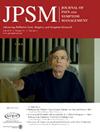为家访护士开发一个量表,以便与癌症患者展开临终讨论。
IF 3.2
2区 医学
Q2 CLINICAL NEUROLOGY
引用次数: 0
摘要
背景:家访护士发现,确定与癌症患者进行生命末期讨论的适当时机具有挑战性:本研究旨在开发生命末期讨论时机量表(T-EOLD),以帮助家访护士确定与癌症患者展开生命末期讨论的适当时机,并测试其信度和效度:方法:量表项目是根据从访谈、文献综述和专家小组讨论中提取的定性数据编制的。我们进行了一项涉及 93 名家访护士的初步研究,并评估了量表的结构效度、一致性和测试-再测可靠性。最后,我们以 234 名家访护士为样本进行了初步研究,并评估了量表的建构效度和一致性:最初共编制了 41 个项目。在初步研究和主要研究中,通过地板效应、项目-总相关性、好-差和探索性因素分析,得出了一个三因素、16 个项目的模型。该模型的拟合优度为 CFI = 0.94,GFI = 0.90,AGFI = 0.87,RMSEA = 0.06。总体量表的 Cronbach's alpha 为 0.91:T-EOLD的信度和效度是可以接受的,因为它是一个合适的量表,家访护士可以用它来确定与癌症患者展开临终讨论的时间。不过,还需要进一步研究 T-EOLD 在国内外的临床实用性。本文章由计算机程序翻译,如有差异,请以英文原文为准。
Developing a Scale for Home-Visit Nurses to Start End-of-life Discussions with Cancer Patients
Context
Home-visit nurses find it challenging to determine the appropriate time to initiate end-of-life discussions with cancer patients.
Objective
This study aimed to develop the Timing of End-of-Life Discussions (T-EOLD) scale to help home-visit nurses determine the appropriate time to initiate end-of-life discussions with cancer patients and to test its reliability and validity.
Methods
The scale items were developed based on qualitative data extracted from interviews, literature reviews, and expert panel discussions. We conducted a preliminary study involving 93 home-visit nurses and evaluated the construct validity, consistency, and test-retest reliability of the scale. Finally, using a sample of 234 home-visit nurses, we conducted the primary study and assessed the construct validity and scale consistency.
Results
A total of 41 items were initially developed. Floor effect, item-total correlation, good-poor, and exploratory factor analysis in the preliminary and primary studies yielded a three-factor, 16-item model. The model's goodness-of-fit was CFI = 0.94, GFI = 0.90, AGFI = 0.87, and RMSEA = 0.06. Cronbach's alpha for the overall scale was 0.91.
Conclusions
The reliability and validity of the T-EOLD is acceptable, as it is an appropriate scale that home-visit nurses can use to determine the time to initiate end-of-life discussions with cancer patients. However, further study is required to examine T-EOLD's clinical utility, both nationally and internationally.
求助全文
通过发布文献求助,成功后即可免费获取论文全文。
去求助
来源期刊
CiteScore
8.90
自引率
6.40%
发文量
821
审稿时长
26 days
期刊介绍:
The Journal of Pain and Symptom Management is an internationally respected, peer-reviewed journal and serves an interdisciplinary audience of professionals by providing a forum for the publication of the latest clinical research and best practices related to the relief of illness burden among patients afflicted with serious or life-threatening illness.

 求助内容:
求助内容: 应助结果提醒方式:
应助结果提醒方式:


